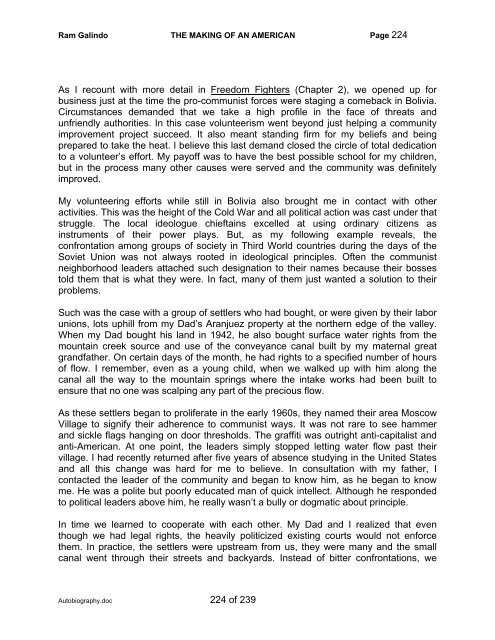Autobiography - The Galindo Group
Autobiography - The Galindo Group
Autobiography - The Galindo Group
You also want an ePaper? Increase the reach of your titles
YUMPU automatically turns print PDFs into web optimized ePapers that Google loves.
Ram <strong>Galindo</strong> THE MAKING OF AN AMERICAN Page 224<br />
As I recount with more detail in Freedom Fighters (Chapter 2), we opened up for<br />
business just at the time the pro-communist forces were staging a comeback in Bolivia.<br />
Circumstances demanded that we take a high profile in the face of threats and<br />
unfriendly authorities. In this case volunteerism went beyond just helping a community<br />
improvement project succeed. It also meant standing firm for my beliefs and being<br />
prepared to take the heat. I believe this last demand closed the circle of total dedication<br />
to a volunteer’s effort. My payoff was to have the best possible school for my children,<br />
but in the process many other causes were served and the community was definitely<br />
improved.<br />
My volunteering efforts while still in Bolivia also brought me in contact with other<br />
activities. This was the height of the Cold War and all political action was cast under that<br />
struggle. <strong>The</strong> local ideologue chieftains excelled at using ordinary citizens as<br />
instruments of their power plays. But, as my following example reveals, the<br />
confrontation among groups of society in Third World countries during the days of the<br />
Soviet Union was not always rooted in ideological principles. Often the communist<br />
neighborhood leaders attached such designation to their names because their bosses<br />
told them that is what they were. In fact, many of them just wanted a solution to their<br />
problems.<br />
Such was the case with a group of settlers who had bought, or were given by their labor<br />
unions, lots uphill from my Dad’s Aranjuez property at the northern edge of the valley.<br />
When my Dad bought his land in 1942, he also bought surface water rights from the<br />
mountain creek source and use of the conveyance canal built by my maternal great<br />
grandfather. On certain days of the month, he had rights to a specified number of hours<br />
of flow. I remember, even as a young child, when we walked up with him along the<br />
canal all the way to the mountain springs where the intake works had been built to<br />
ensure that no one was scalping any part of the precious flow.<br />
As these settlers began to proliferate in the early 1960s, they named their area Moscow<br />
Village to signify their adherence to communist ways. It was not rare to see hammer<br />
and sickle flags hanging on door thresholds. <strong>The</strong> graffiti was outright anti-capitalist and<br />
anti-American. At one point, the leaders simply stopped letting water flow past their<br />
village. I had recently returned after five years of absence studying in the United States<br />
and all this change was hard for me to believe. In consultation with my father, I<br />
contacted the leader of the community and began to know him, as he began to know<br />
me. He was a polite but poorly educated man of quick intellect. Although he responded<br />
to political leaders above him, he really wasn’t a bully or dogmatic about principle.<br />
In time we learned to cooperate with each other. My Dad and I realized that even<br />
though we had legal rights, the heavily politicized existing courts would not enforce<br />
them. In practice, the settlers were upstream from us, they were many and the small<br />
canal went through their streets and backyards. Instead of bitter confrontations, we<br />
<strong>Autobiography</strong>.doc 224 of 239


